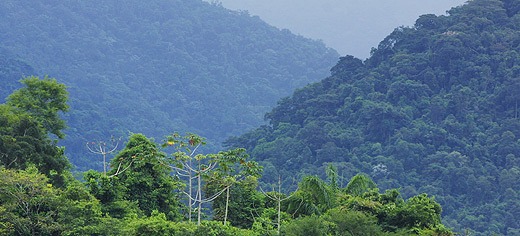
Researchers report that continued deforestation of the Amazon rainforest could diminish rainfall levels in the Amazon River basin, which may impact the region’s climate, ecosystems and economies.
A new study, published on Thursday 12 November in Geophysical Research Letters, predicts that by the middle of the century annual rainfall in the Amazon could be less than the yearly amount of rain the region receives during drought years if deforestation rates revert back to pre-2004 levels.
Study lead author Dr Dominick Spracklen, from the School of Earth and Environment at the University of Leeds, said: “Essentially, drought years could become the norm for the Amazon by 2050 if deforestation rates rebound.
This significant drop in rainfall could affect ecosystems and wildlife throughout the entire Amazon basin, which covers roughly 40% of South America.
“Recent droughts in the Amazon in 2005 and 2010 showed that sustained reductions in rainfall could have massive consequences for Brazil’s economy.
Less rain could affect agriculture, which currently generates $15 billion a year for Brazil’s economy, and hydropower, which generates 65% of Brazil’s electricity.”
Deforestation of the Brazilian Amazon started on a large scale in the 1970s. The opening of the Trans-Amazonian Highway in 1972 made the interior of the Amazon accessible for the first time, sparking a blast of forest clearing to create space for cattle ranching and agriculture.
In Brazil, home to two-thirds of the Amazon rainforest, deforestation rates accelerated throughout the following decades until reaching a peak in 2004.
That year, Brazil cleared 2.7 million hectares (6.7 million acres) of forest – the equivalent of 7,400 hectares (18,300 acres) a day, according to Brazil’s National Institute for Space Research (INPE).
At that rate, researchers estimated nearly half of the original forest cover would be gone by 2050.
After hearing these predictions, Brazil enacted laws to preserve the country’s remaining rainforest. Deforestation began to decline in 2005, and by 2010, forest clearing rates had dropped to about 25% of 2004 levels, according to INPE.
During the same time period, however, deforestation in other Amazonian countries increased, according to Spracklen.
With a high global demand for increased beef and soy production, it’s likely these countries will continue clearing forest and possible Brazil will relax its forest protection laws to meet those demands, according to Spracklen.
“I think one of the big environmental success stories of the past decade has been the reduction in deforestation in the Amazon, within Brazil,” Spracklen said.
“But I think at the moment we’re at a kind of cusp, where there’s continued pressure within Brazil to relax some of the forest laws.”
Forests mediate the exchange of water, energy and gases between the Earth’s surface and the atmosphere. As a result, clearing forests can affect local temperature, humidity and rainfall, but these effects can be difficult to quantify.
Researchers use atmospheric models to simulate this process in the Amazon. Many of these simulations show an association between forest cover and rainfall, but every model is different and makes different assumptions.
In the new study, researchers analysed the results of 96 existing climate models to see if there was any consensus among them.
Study co-author Dr Luis Garcia-Carreras, also from the University of Leeds’ School of Earth and Environment, said: “We wanted to make a comprehensive assessment using all of the information that was available until now to give us the best estimate of what the impact of deforestation would be on rainfall.”
Performing a meta-analysis of the 96 models, the study found that if deforestation rates return to pre-2004 levels, annual rainfall in the Amazon will decrease 8% by 2050.
Dr Garcia-Carreras concludes: “We found a very consistent picture that deforestation is going to drive a reduction in rainfall, and that was consistent virtually across all models and all studies that we analysed.”
Further information
The research paper, “The impact of Amazonian deforestation on Amazon basin rainfall” is published in the journal Geophysical Research Letters on 12 November 2015.
Dr Dominick Spracklen and Dr Luis Garcia-Carreras are available for interview. Please contact Sarah Reed, Press Officer at the University of Leeds, on 0113 34 34196 or email s.j.reed@leeds.ac.uk.
Video
Time-lapse of Amazon deforestation in the state of Rondonia in Brazil, from 2000-2010. Images taken by the Moderate Resolution Imaging Spectroradiometer (MODIS) on NASA’s Terra satellite.
Credit: NASA/Goddard Space Flight Center.